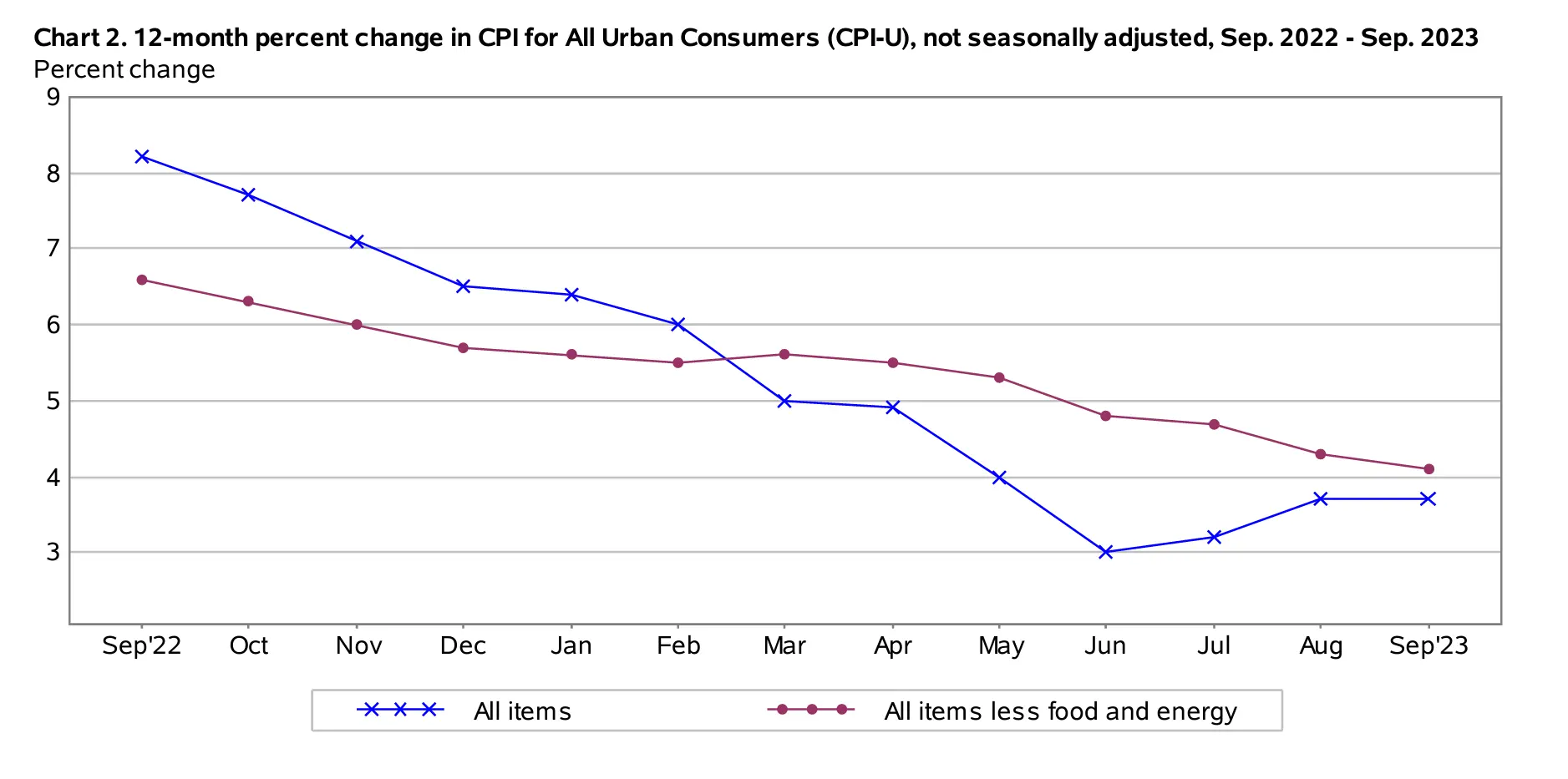The September 2023 report of the Consumer Price Index of All Urban Consumers (CPI-U) indicates that inflation increased by a lesser margin than August’s 0.6% month-over-month bump that was largely driven by rising gasoline prices. The CPI-U increased by 0.4% on a seasonally unadjusted basis in September 2023, according to the Bureau of Labor Statistics report published October 12, 2023. Before seasonal adjustment, the year-over-year (Y-o-Y) inflation rate in the all-items index grew by 3.7%, marking an identical increase to August’s CPI report.
September’s CPI report came in a bit hotter than anticipated according to a CNBC forecast that cited 0.3% and 3.6% month-over-month and annual increases, respectively.
Financial markets opened on Thursday morning at a loss following September’s inflation news. The Dow Jones Industrial Average is down 90.55 points as of 11:30 a.m. on Wednesday, and the S&P 500 is down by 4.19 points.
The main drivers of inflation according to September’s inflation report are shelter costs, which rose by 7.2% on a year-over-year basis. On a macro-economic level, the ongoing inflationary conditions appear to cast doubt on whether the Federal Reserve will issue yet another interest rate hike at the next Federal Open Market Committee meeting on October 31. Given hotter-than-expected inflation data, all signs currently point to there being another 0.25 basis point rate hike before year-end.
Source: Bureau of Labor Statistics
September’s monthly CPI figure marks a deceleration from August’s (0.6%) while outpacing July’s reading (0.2%). As depicted in the table above, the September 2023 CPI figure was largely driven by increases in shelter costs (7.2), transportation services (9.1) and food away from home (6.0).
Food Prices
In September, the food index rose by 0.2 percent, the same marginal increase seen in both August and July. Notably, the index for food away from home rose by 0.4 percent, doubling the food at home index increase. Important price decreases include meat, poultry, fish, and eggs, which rose 0.5 percent in September, while bakery products and cereals decreased by 0.4%, marking the first time that this index segment decreased since June 2021.
Energy Prices
The energy index rose by 1.5 percent in September following a large 5.6 percent increase in August due, largely, to base year effects. The index for electricity rose 1.3 percent in September, a notable increase from August’s 0.2 percent uptick. Fuel oil represented a large portion of September’s energy price increases, rising 8.5 percent while the natural gas index decreased by 1.9 percent.
On an annual basis, the energy index fell by 0.5 percent with mixed components, including the natural gas index falling 19.9 percent year-over-year and the gasoline index rising 3.0 percent in September.
Core September 2023 CPI
Regarding the core CPI data for September 2023 (i.e., inflation less food and energy), the index rose 0.3 percent month-over-month, matching August’s increase and marking an increase from July and June’s core CPI acceleration of 0.2 percent. Below is an itemized breakdown of the main price fluctuations seen in September’s core CPI reading:
- Rent index: +0.5%
- Lodging away from home: +3.7%
- Motor vehicle insurance: +1.3%
- Medical care index: +0.2%
- Used cars and trucks: (-2.5%)
- Recreation +3.9%
- Personal care items: +6.1%
Source: Bureau of Labor Statistics
Seasonally Unadjusted CPI Data for September 2023
Before seasonal adjustments, the CPI-U for September 2023 increased (+3.7%) year-over-year, rising to an index level of 307.789. Since these figures are unadjusted, they include regular seasonal price fluctuations that generally occur by the same margins every year.
Source: Bureau of Labor Statistics
Get Ahead of Inflation This Autumn: Protect Your Wealth
September’s inflation numbers indicate that August’s CPI reading wasn’t a fluke. Price increases are here to stay, despite the Fed’s hawkish rate hike campaign. The end result is that every American family has less purchasing power compared to this time last year, and the average American worker has less of their pay check to devote to monthly expenses. All the while, personal debts are rising fast—in fact, America’s total credit card debt exceeds $1 trillion and student loan repayments are once again mandatory after an over 3-year freeze on interest accumulation.
The good news is that you have the power to counteract the negative effects of inflation and other worrisome macroeconomic indicators. Consider consulting with a financial expert about diversifying your investment portfolio with alternative assets. Hard investments in gold and silver have the potential to shield your savings from the diminishing value of the U.S. dollar and help you retain your wealth during inflationary environments.
Historical events in 2008 and 2020 have shown that assets like gold and silver have outperformed conventional securities during market turbulence. For many, gold serves as a safeguard against inflation, offering a dependable store of value when traditional assets falter.
Considering taking a position in gold or silver? Get started by opening an account with one of the top-rated gold IRA service providers. In the meantime, our complimentary CPI inflation calculator tool can help you monitor how inflation affects your purchasing power within your household over the coming months.






